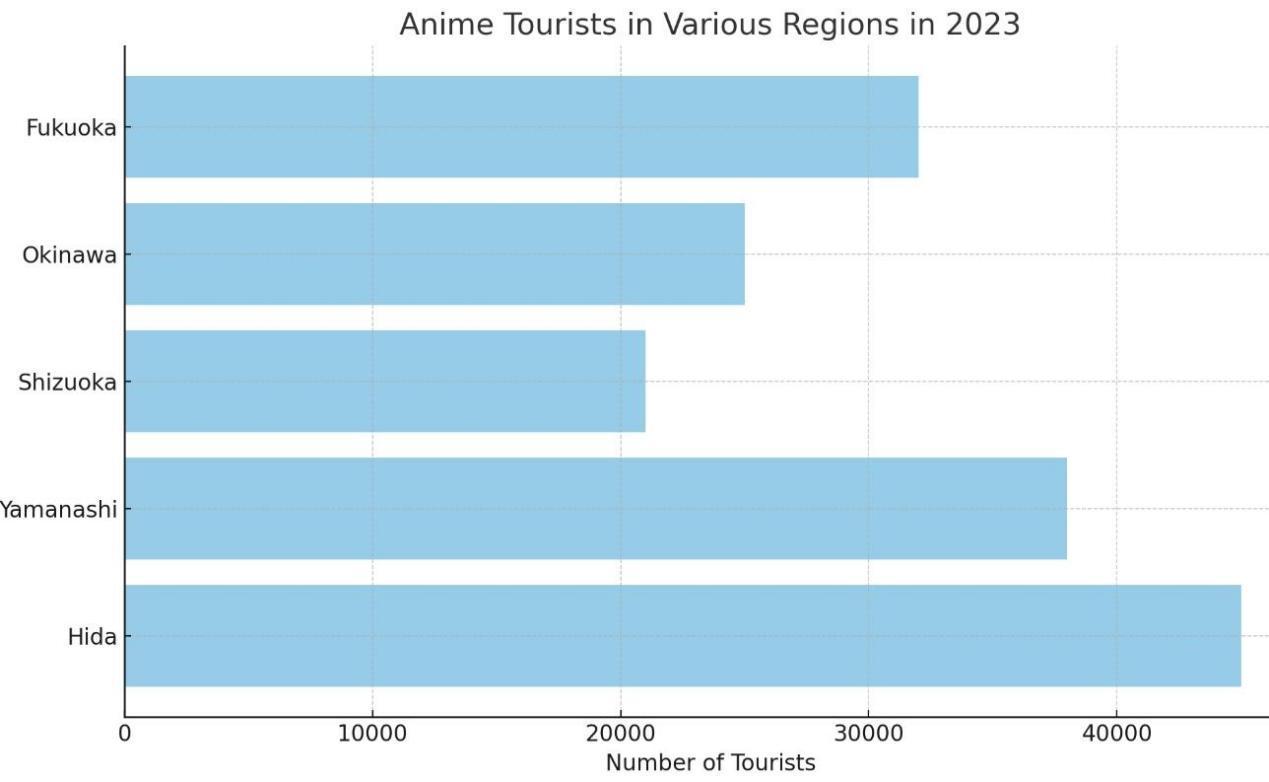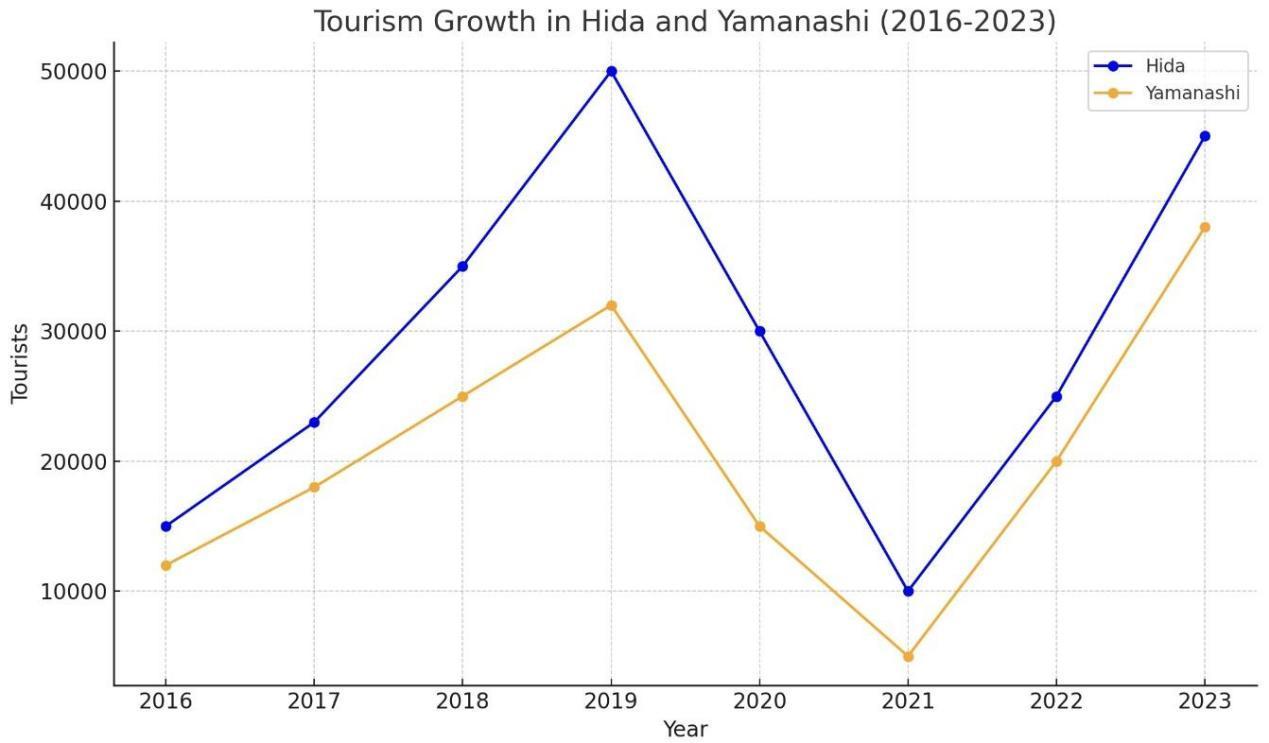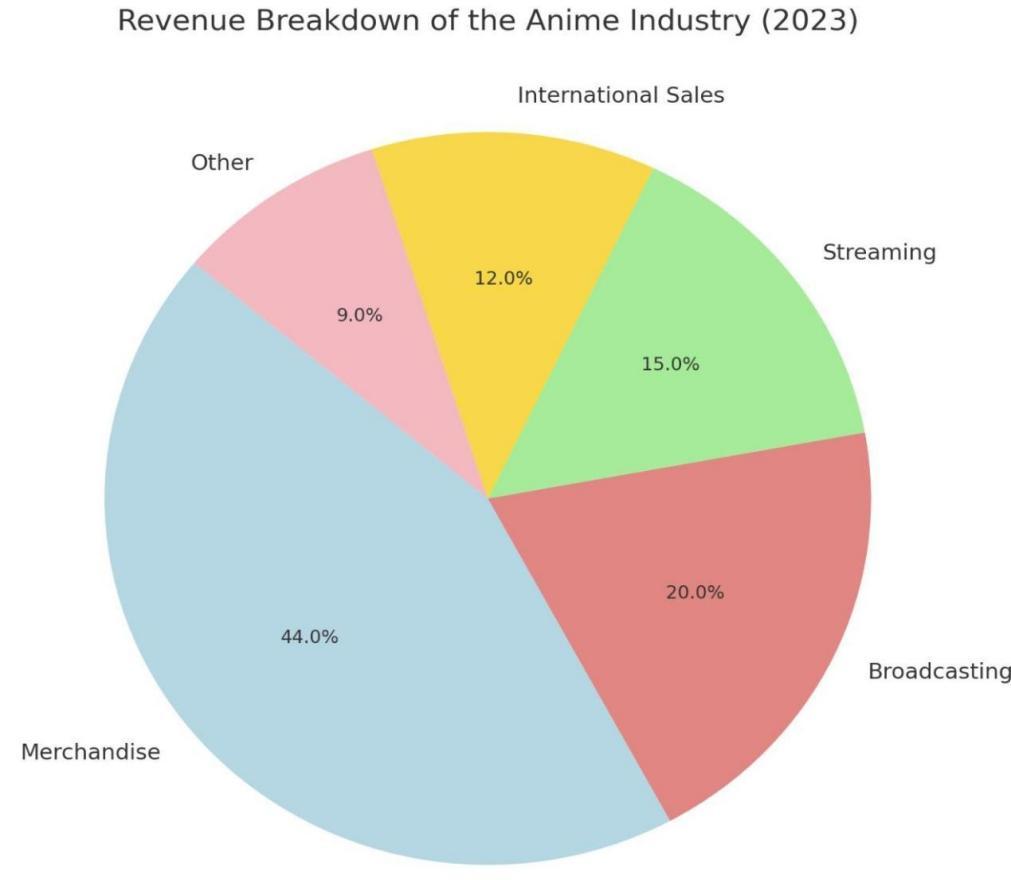1. Introduction
The anime industry in Japan has grown rapidly in recent years, becoming one of the country's major ways of sharing its culture with the world. At the same time, the growth of the anime industry has provided new energy for Japan's domestic economy. As the problem of uneven regional development within Japan has intensified over the past few years, many local governments and businesses have started to consider whether anime and its related industries can become an effective policy to revitalize the economy in Japan's less developed areas. These less developed areas often face issues like a simple economic structure, population decline, and limited resources for growth. However, the anime industry, as a new era digital industry, is highly creative and can lead audience consumption, which could help boost related industries[1,2]. By combining local characteristics with creative content, anime not only promotes the development of tourism but also drives the sales of peripheral goods, copyright transactions, and other aspects of economic benefits [3].
Although there have been numerous studies exploring the positive impact of the anime industry on specific cities or regions, research on how to specifically design and implement effective policies to maximize the potential of the anime industry to support the comprehensive development of underdeveloped areas remains insufficient. Additionally, there is relatively little research on how cities of different sizes and stages of development should choose appropriate paths for the development of their anime industries based on their own characteristics [4].
This paper will explore how the anime industry can boost the economic vitality of less developed regions in several ways. Firstly, the strong cultural influence and brand effect of anime and its related industries can drive tourism growth. The phenomenon of "pilgrimage" tourism, where fans visit real-life locations featured in anime, brings new visitors to these areas, enhancing local services and increasing recognition. Higher visibility attracts more tourists and external resources such as business investments. Secondly, the production of anime-related goods, including crafts, clothing, and toys, stimulates local manufacturing, creating jobs and fostering an internal economic cycle. Additionally, with rising global demand for digital content, some regions are collaborating with companies to produce anime and games that highlight local attractions, attracting investment and offering new job opportunities for youth. Finally, this paper will examine how combining the anime industry with local culture can promote both cultural preservation and economic development. By integrating traditional culture with anime, unique cultural products can be created, enhancing the region's cultural value and driving commercialization.
2. Overview of Japan's anime industry and the economic status of underdeveloped regions
Japan's anime industry has grown rapidly in recent years and has become one of the main ways Japan shares its culture with the world. At the same time, the growth of the anime industry has also brought new energy to Japan's economy. As the problem of uneven regional development has worsened in recent years, many local governments and businesses are starting to consider whether the anime industry can be an effective way to boost the economy in less developed areas of Japan. These areas often face issues like a simple economic structure, declining population, and limited growth resources. Anime, as a modern digital industry, shows great commercial potential because it is highly creative and strongly influences consumer behavior [5].
The storytelling and visual quality in anime make it more effective at driving related industries compared to other traditional industries. The growth of the anime industry not only boosts virtual consumption but also promotes the production and sales of related products like figurines, which are important for the recovery of regional economies. Although the impact of COVID-19 is still present, leading to a significant drop in both foreign and domestic tourists, most foreign tourists visit for landmarks and food rather than anime-related products, which limits the economic effect. However, as a digital industry, anime has a strong ability to reach people through online platforms, which can still bring economic vitality to these less developed areas. Although the anime industry shows great potential, its development in less developed areas also faces some challenges, such as a lack of local infrastructure, a shortage of skilled workers, and the need to integrate local cultural resources. These problems could limit the further growth and success of the anime industry [6]. Therefore, local governments and businesses need to create strategies, such as improving infrastructure, offering professional training, and working closely with anime production companies to include local cultural features in anime works. By overcoming these challenges, less developed areas have a chance to achieve sustained economic growth through the anime industry. For example, successful cases like the anime "Laid-Back Camp" and "Girls und Panzer" show how local governments and businesses, which developed anime tourism and organized related events, greatly boosted the local economy. These experiences can provide valuable lessons for other regions [7]. Therefore, exploring how the anime industry can play a bigger role in economic recovery after the pandemic is of great research value (Figure 1).

Figure 1: Anime tourists in various regions in 2023 (Photo/Picture credit : Original)
After the COVID-19 crisis, Japan's economy has slowly started to recover as governments around the world allowed people to travel again. The large number of tourists coming in has also helped Japan's tourism industry bounce back (Figure 2). As the economy recovers, many anime companies have begun to invest more in making new anime. For example, there were 186 anime made in the fourth quarter of 2022, but in 2023, that number jumped to 365 (Figure 3). The anime industry and the production of anime-related products have also helped local manufacturing grow. This includes areas like handicrafts, clothing, and toys. The production of these goods has created many job opportunities, which helps improve the local economy in less developed regions, making these areas more able to grow on their own.
In 2024, Japan has started to grow again as tourist numbers rise, but the wealth from this growth has not been shared equally across the whole country [8]. Many rural and less developed areas still face problems like a shrinking population, aging people, and young people leaving for big cities like Tokyo and Osaka. These problems make the local job market smaller, which causes the economy, especially in farming and industry, to slow down even more. The Japanese government has tried different economic plans to help these less developed areas. Local governments are working on building new infrastructure, improving tourism, and raising education levels to improve the local economy.

Figure 2: Tourism growth in Hida and Yamanashi (Photo/Picture credit : Original)
At the same time, the digital industry is seen as a way to help less developed regions recover. As the global demand for digital content like anime and games keeps growing, more companies are working with local governments in these areas. They are using local resources and culture to create digital content [9]. These high-value industries attract outside money, which also gives local young people more jobs, reducing their need to move to big cities for work. While some of these policies have started to work, the recovery in Japan’s less developed regions is still very difficult. The government expects Japan’s overall economy to grow by about 1.0% in 2024, but this is not enough to fully change the situation in rural areas. In the long run, continuing to invest in infrastructure, training workers, and bringing in new industries will be the key to helping these areas grow steadily. This shows that the situation in less developed regions is still quite tough.

Figure 3: Anime production growth (2020-2023) (Photo/Picture credit : Original)
3. The impact of the anime industry on regional economic development
The anime industry’s impact on tourism is very clear, especially because of fan-driven economies. Great anime works lead to cultural exchange and stimulate local economies, which shows their broad influence. Fans of certain anime often visit real-world locations or buildings that appear in the shows. This behavior is called "pilgrimage," where fans travel to these places to get a more immersive experience of the anime. For example, the small town of Hida was not well known before, but after the anime Your Name was released, many visitors came, which increased the town's popularity and boosted the income of local restaurants and hotels. This kind of tourism is not only popular in Japan but also attracts many foreign visitors [10]. Even though the pandemic affected tourism, after Japan reopened in 2022, a significant number of tourists came because of anime, which shows that anime culture is one of Japan’s key strengths in attracting international visitors.
The market for anime-related products has also created many jobs for local economies and brought big profits for companies. According to 2023 data, 44% of the total revenue in the anime industry came from merchandise like figures, toys, and clothing (Figure 4). Large-scale production of anime products helps small production companies in less developed areas grow. A good example is Demon Slayer, which became very popular and brought huge profits to its copyright holders. By licensing its IP to other companies to make merchandise, Demon Slayer created a high demand for production, which led factories across Japan to start producing and designing packaging. This helped both the upstream and downstream industries grow, bringing many benefits to less developed regions. The government can support small and medium-sized businesses by providing talent and policy assistance, which will help them connect with international markets and improve their production and design skills, keeping them competitive in the anime market.

Figure 4: Revenue breakdown of the Anime industry (2023) (Photo/Picture credit : Original)
One of the biggest trends in the anime industry in recent years is the merging of digital and creative industries. In 2020, due to the pandemic, the traditional ways of making and distributing anime were affected, but the online streaming market grew by 35.8%. Platforms like Netflix and Crunchyroll bought and streamed Japanese anime, which made anime more popular worldwide and helped develop the digital creative industry. This growth wasn’t just limited to anime itself but also expanded into new fields like games. For example, the anime Cyberpunk: Edgerunners not only promoted the original game Cyberpunk 2077 but also boosted the entire cyberpunk-themed creative industry. This kind of collaboration may become more common in the future, creating new growth opportunities for Japan’s digital content industry [11,12]. Japan’s government and companies need to invest more in digital creative industries to take advantage of these new opportunities. Strengthening non-physical industries is one of the best ways to improve the economy in less developed areas, especially with technologies like virtual reality and augmented reality.
Anime can also represent more than just modern culture; it shows the charm of traditional Japanese culture when combined with anime. A great example of this is Hayao Miyazaki’s Spirited Away, which mixes anime with Japanese local beliefs and traditional culture. Through anime, the movie attracts a large audience with its lively visuals. Its success is not just in the box office but also in how it uses a captivating story to introduce global audiences to traditional Japanese culture. This kind of digital cultural communication protects and spreads traditional culture while also bringing economic benefits. Studio Ghibli, through its cultural elements in their works, has drawn many visitors to the Ghibli Museum in Tokyo [13]. This museum not only showcases Miyazaki’s famous works but also generates tourism income through merchandise, food, and exhibitions. Japan, even though it is a small island country, has many rich local traditions and myths, which is one of the best ways less developed regions can attract more tourists. Combining local traditional culture and myths with anime, using appealing visuals and stories, can attract tourists from all over the world to visit.
While we are excited about the potential benefits that the anime industry can bring to less developed areas in Japan, the challenges these regions face cannot be ignored. Building infrastructure in these areas, which often lack resources and economic income, is a big problem. There are not enough facilities to support businesses and tourism. Another issue is how to effectively combine local cultural resources with anime content, which requires creativity and cooperation between local governments and anime creators. If local governments cannot successfully mix their unique cultural elements with the anime industry, the economic potential of these projects may be greatly reduced. Competitors from more developed cities, such as Tokyo, where most anime production happens, also limit the opportunities for rural areas. Lastly, even though the demand for digital content is growing around the world, these less developed regions lack the digital infrastructure needed to join this market, which means they cannot benefit right away. Strong cooperation between the government and local areas is needed for the initial investments to succeed.
4. Conclusion
This paper delves into the multifaceted ways in which Japan's anime industry can serve as a catalyst for economic growth in less developed areas. By examining a variety of avenues—including tourism, the anime industry itself, and the production of related merchandise—this study underscores the potential of anime to invigorate local economies. It presents tangible examples of how anime-centric content and events have already made a significant impact, generating jobs, fostering local entrepreneurship, and stimulating the demand for a range of services and products.
Looking toward the future, the cooperation among local governments, businesses, and anime creators will prove to be critical in harnessing the full potential of this industry. Such collaboration can enhance the cultural richness and economic viability of anime, ensuring that its benefits reach a broader audience. With proper policy support and a focus on infrastructure enhancement, the anime industry stands poised to become a vital instrument for economic recovery in the post-pandemic era. This holistic approach will not only enrich the local culture but also create sustainable economic opportunities for communities striving for growth.
References
[1]. Inoue, S. (2020). The Impact of Anime on Japan’s Creative Industries: A Historical Perspective. In K. Abe (Ed.), Japan’s Creative Industries in the21st Century (pp.123-144). .
[2]. Bank of Japan. (2024). Outlook for economic activity and prices (January 2024). Bank of Japan.
[3]. Yomota, H. (2019). The 'Cool Japan' Strategy: Cultural Diplomacy and Economic Growth. In Cultural Diplomacy and the Challenge of Globalization (pp.75-92)..
[4]. Chen, L. (2020). The impact of anime on Japan’s creative industries. In K. Abe (Ed.), Japan’s creative industries in the 21st century (pp. 123-144).
[5]. Cool Japan Fund and Its Role in Economic Revitalization. (2014). Japan Spotlight. Discusses METI’s strategy to support anime and other cultural industries as part of Japan’s economic growth
[6]. Japanese Cultural Exports and Regional Economic Impact. (2022). Brunel University. Analysis of anime’s influence on Japan’s economy through cultural export and regional revitalization initiatives.
[7]. Nakamura, T. (2022). The Economic Impact of Japanese Cultural Exports: A Case Study of Anime. Journal of Cultural Economics, 45(3), (pp.345-361).
[8]. Foreign Press Center Japan. (2024). Briefing: Japan's economic policy challenges. Foreign Press Center Japan.
[9]. Smith, R. (2022). Mapping Japan’s Anime Industry: Cultural Impact and Economic Growth. International Journal of Cultural Studies, 25(4), (pp.509-526).
[10]. Anime’s Economic Value and the Government’s Response to Changing Markets. (2022). Springer. Discusses how the Japanese government leverages anime as part of the Cool Japan policy to stimulate economic growth.
[11]. Daiwa Institute of Research. (2024). Japan’s monthly economic report (June 2024). Daiwa Institute of Research (pp.1-4).
[12]. Tanaka, Y. (2022). Anime’s Economic Value: Government Policies and Market Dynamics. Cultural Policy Review, 15(1), (pp.45-62).
[13]. Anime News Network. (2022). AJA releases anime industry report summary for 2020 in English. Anime News Network. https://www.animenewsnetwork.com/daily-briefs/2022-03-30/aja-releases-anime-industry-report-summary-for-2020-in-english/.184177
Cite this article
Nie,Q. (2025). How the Japanese Anime Industry Can Revitalize Underdeveloped Regions. Advances in Economics, Management and Political Sciences,152,169-175.
Data availability
The datasets used and/or analyzed during the current study will be available from the authors upon reasonable request.
Disclaimer/Publisher's Note
The statements, opinions and data contained in all publications are solely those of the individual author(s) and contributor(s) and not of EWA Publishing and/or the editor(s). EWA Publishing and/or the editor(s) disclaim responsibility for any injury to people or property resulting from any ideas, methods, instructions or products referred to in the content.
About volume
Volume title: Proceedings of the 3rd International Conference on Financial Technology and Business Analysis
© 2024 by the author(s). Licensee EWA Publishing, Oxford, UK. This article is an open access article distributed under the terms and
conditions of the Creative Commons Attribution (CC BY) license. Authors who
publish this series agree to the following terms:
1. Authors retain copyright and grant the series right of first publication with the work simultaneously licensed under a Creative Commons
Attribution License that allows others to share the work with an acknowledgment of the work's authorship and initial publication in this
series.
2. Authors are able to enter into separate, additional contractual arrangements for the non-exclusive distribution of the series's published
version of the work (e.g., post it to an institutional repository or publish it in a book), with an acknowledgment of its initial
publication in this series.
3. Authors are permitted and encouraged to post their work online (e.g., in institutional repositories or on their website) prior to and
during the submission process, as it can lead to productive exchanges, as well as earlier and greater citation of published work (See
Open access policy for details).
References
[1]. Inoue, S. (2020). The Impact of Anime on Japan’s Creative Industries: A Historical Perspective. In K. Abe (Ed.), Japan’s Creative Industries in the21st Century (pp.123-144). .
[2]. Bank of Japan. (2024). Outlook for economic activity and prices (January 2024). Bank of Japan.
[3]. Yomota, H. (2019). The 'Cool Japan' Strategy: Cultural Diplomacy and Economic Growth. In Cultural Diplomacy and the Challenge of Globalization (pp.75-92)..
[4]. Chen, L. (2020). The impact of anime on Japan’s creative industries. In K. Abe (Ed.), Japan’s creative industries in the 21st century (pp. 123-144).
[5]. Cool Japan Fund and Its Role in Economic Revitalization. (2014). Japan Spotlight. Discusses METI’s strategy to support anime and other cultural industries as part of Japan’s economic growth
[6]. Japanese Cultural Exports and Regional Economic Impact. (2022). Brunel University. Analysis of anime’s influence on Japan’s economy through cultural export and regional revitalization initiatives.
[7]. Nakamura, T. (2022). The Economic Impact of Japanese Cultural Exports: A Case Study of Anime. Journal of Cultural Economics, 45(3), (pp.345-361).
[8]. Foreign Press Center Japan. (2024). Briefing: Japan's economic policy challenges. Foreign Press Center Japan.
[9]. Smith, R. (2022). Mapping Japan’s Anime Industry: Cultural Impact and Economic Growth. International Journal of Cultural Studies, 25(4), (pp.509-526).
[10]. Anime’s Economic Value and the Government’s Response to Changing Markets. (2022). Springer. Discusses how the Japanese government leverages anime as part of the Cool Japan policy to stimulate economic growth.
[11]. Daiwa Institute of Research. (2024). Japan’s monthly economic report (June 2024). Daiwa Institute of Research (pp.1-4).
[12]. Tanaka, Y. (2022). Anime’s Economic Value: Government Policies and Market Dynamics. Cultural Policy Review, 15(1), (pp.45-62).
[13]. Anime News Network. (2022). AJA releases anime industry report summary for 2020 in English. Anime News Network. https://www.animenewsnetwork.com/daily-briefs/2022-03-30/aja-releases-anime-industry-report-summary-for-2020-in-english/.184177









